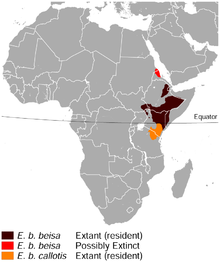Oryx_beisa_beisa
The common beisa oryx (Oryx beisa beisa), also known as the beisa oryx, is the nominate subspecies of the East African oryx native to the Horn of Africa and Kenya. It is closely related to the fringe-eared oryx. There are four species of oryx, one of which has two distinct subspecies. Although they are very similar in appearance, they have a number of distinct characteristics that allow identification. Common beisa oryx have fringed ears and black tufts of hair that extend past their ears. However, all species of oryx are compact and muscular, with relative long bodies and broad necks. There are not any marked difference between male and female oryx. The common beisa oryx enjoys feeding on a variety of grass species. They feed during the day, when the plants hold the most water. During the dry season, they feed on poisonous Adenium plants.
This article needs additional citations for verification. (July 2017) |


